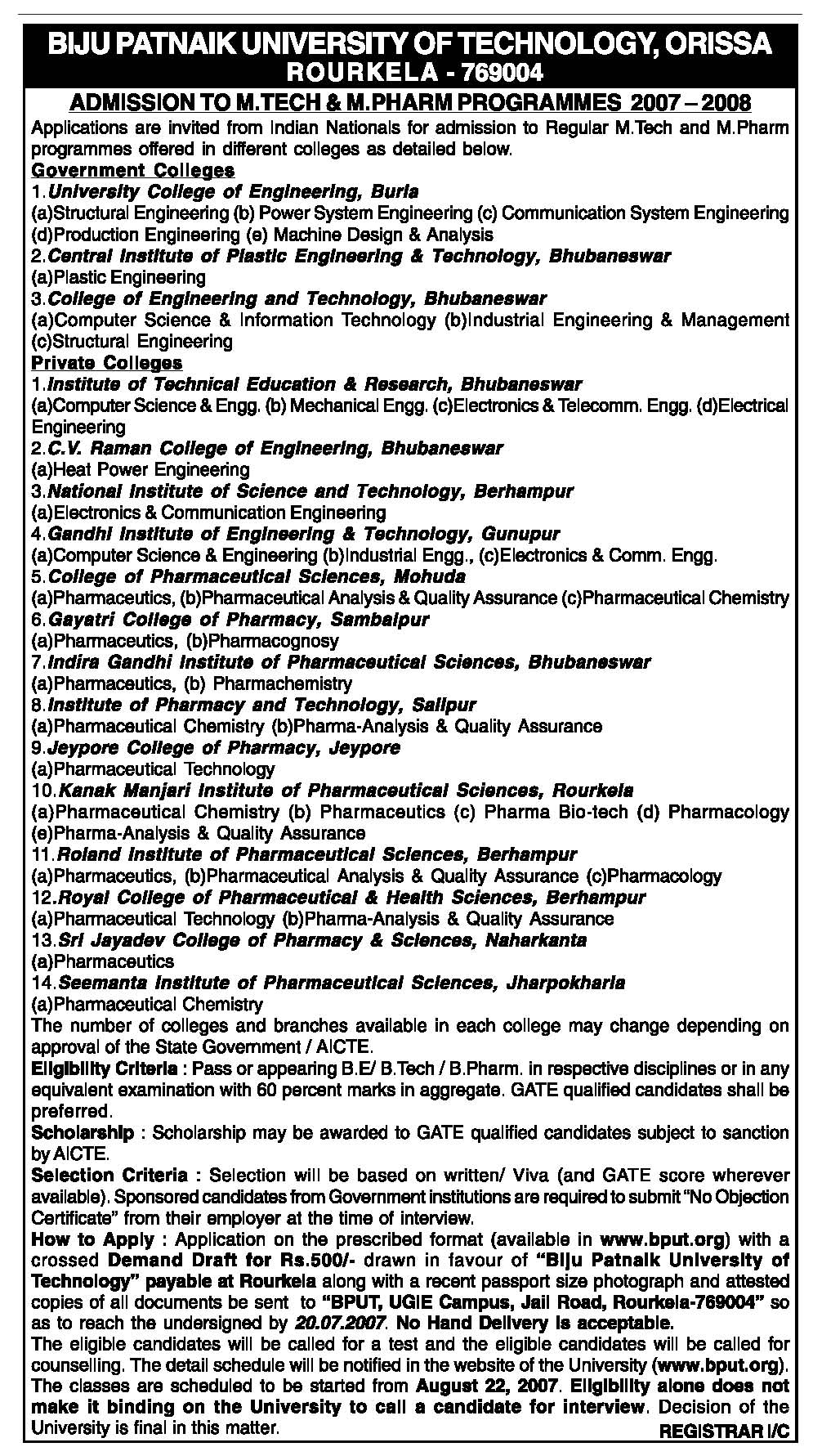Hindustan Times reports on further development on the HRD front with respect to the 11th plan. Following are some excerpts.
… Planning Commission recommending higher remuneration for faculty and mandatory curricula revision every three years.
The commission said the government should look at alternate ways to improve the wages of professors and to tap the large pool of teachers of Indian origin. "The faculty can get a share of the money earned from research projects for the corporate world. Even research students can earn from these," a government official said.
The commission also proposed that some faculty be recruited on salaries higher than government pay scales, on contract basis for five years with no assurance of automatic renewal. The contract system would be mostly for NRIs with special research funding support. Tenured appointments should also be available at a certain stage for professors achieving objectively set academic standards, Planning Commission vice-chairperson Montek Singh Ahluwalia said in a presentation to the PM. …
The government aims to bring two per cent students under the scholarship fold and double the number of junior research fellowships. This is aimed at improving research quality. It is also working on information communication technology for all 367 universities and on connecting 18,000 colleges through the National Knowledge Network, as recommended by the National Knowledge Commission, the commission said.
The commission also said it had given in-principle approval to the setting up of three new IITs, seven new IIMs, 20 National Institutes of Technology, five Indian Institutes of Science Education Research, 20 IIITs, two Schools of Planning and Architecture.
Lets elaborate a bit on the last sentence.
- The three IIT locations are announced as Bihar, Rajasthan and Andhra Pradesh.
- Among the seven new IIMs, Andhra Pradesh, Bihar and Shillong (Meghalaya) are three of the locations. The remaining four locations are as yet unrevealed. (This calculation probably does not take into account the recent news that IIM Lucknow is establishing a campus in NOIDA, in the New Delhi metropolitan area. Also, note that IIM Bangalore is making good progress towards establishing a campus in Singapore.)
- The 20 NITs are existing ones.
- The five IISERs are in Kolkata, Pune, Mohali (Punjab), Kerala and Bhopal.
- The 20 IIITs will be one in each of the major states.
- The two SPAs are announced to be in Bhopal and Vijaywada.
July 7th, 2007
This PIB article mentioned plans for establishing new central universities. Hindustan Times has a news report elaborating on various aspects of the new central universities. Following are some excerpts:
A common entrance admission test for all Central universities, a uniform semester and credit system to allow easy mobility for students may come into force. …
“The common national entrance test for 30 Central Universities, including 14 new ones to be set up, to ensure top quality student intake, would be the same as the JNU test, which is well regarded and has been accepted,” a senior government official said.
JNU governance model of complete autonomy will also be adopted in all universities to check “political interference” in the appointment of vice-chancellors and faculty, the official added.
The semester system would also be similar to that of JNU’s, with a facility for a student to break away for a year or two and return, if he or she wishes.
All new 14 Central universities will have an engineering school, a management school and a law school, but would be allowed to charge higher fees than the conventional courses, the presentation states.
The presentation also recommends increasing the fee for undergraduate courses to Rs 12,000 per annum with 40 per cent of students getting substantial scholarships.
“The fee structure should cover 20 per cent of the cost for running the university,” the official said. The government also wants to set up a Central government loan guarantee mechanism, which will cover 75 per cent of the loan amount in case of default by students obtaining loans from the banks.
The underlined sentence above says 14 new central universities, while the PM’s address had said 30 central universities. Perhaps it may mean that there will be 14 new central universities while 16 will be upgradations. If that is the case and indeed the new central universities have an engineering school, a management school and a law school, then all these will most likely would be part of the earlier mentioned central university in Koraput. That would be really great.
July 6th, 2007
India can not progress much if it leaves behind big parts of its population and areas; same is true for Orissa. Unfortunately the most backward areas of India also happen to be in Orissa. We must make sure that these areas are given adequate attention by all governments.
1. Some statistical points on KBK, the most backward districts in Orissa as well as India; on Orissa and on MHRD spending in Orissa.
(a) Population below the poverty line in southern Orissa (of which KBK is a part) is reported to be 89.17% of the people according to the 1999-2000 NSS data and 72% of the families according to the 1997 census.
(b) The literacy rates in the KBK districts are abysmally low. Malkangiri 31.26%, Nabarangpur 34.26%, Rayagada 35.61%, Koraput 36.2%, Nuapada 42.29%, Kalahandi 46.2%, Balangir 54.93%, Sonepur 64.07%. Two adjacent districts also have low literacy: Gajapati 41.73% and Kandhamala 52.95%. The state average is 63.1%.
(c) The tribal population percentage of the KBK districts are as follows: Malkangiri 58.36% (+19.96% SC), Rayagada 56.04% (+14.28% SC), Nabarangpur 55.27% (+15.09% SC), Koraput 50.67% (+13.41% SC), Nuapada 35.95% (+13.09% SC), Kalahandi 28.88% (+17.01% SC), Sonepur 22.11% (+9.5% SC), Balangir 22.06% (+15.39% SC). Two adjacent districts also have high tribal population. They are Kandhamala 51.51% (+18.21% SC) and Gajapati 47.88% (+8.77% SC)
(d) KBK needs sons of the soil, (highly) educated in the soil teachers, doctors, engineers, officers etc. to help in bringing KBK to the main stream of Orissa and India. With a high tribal population, it is important that they have higher education opportunities right where they live as often they do not venture out to Delhi, Hyderabad, Allahabad or Benaras to take advantage of the ST seats in the high quality central universities there and the ones that venture out do not usually return home. In this regard one must note that in the US a major percentage of Blacks, Hispanics and Native Americans who have a higher education degree have it from colleges and universities (such as HBCUs — Historically Black Colleges and Universities) near their home rather than in far flung universities.
(e) Central government spending in fully centrally funded higher education institutions in Orissa is towards the bottom among all states in India. A rough calculation in http://www.baral.us/hrd-nh.htm showed that while the central government spent (in 2005-06) per person Rs 4.07 on fully-funded-by-center HRD institution in Orissa, it spent Rs 177.12 in Delhi, Rs 105.42 in Uttaranchal, Rs 105 in Arunachal Pradesh, Rs 77.7 in Assam, Rs 33.78 in Himachal Pradesh, Rs 28.10 in West Bengal, Rs 25.12 in Karnataka, Rs 17.79 in Tamil Nadu, Rs 17.09 in Maharastra, Rs 17.08 in UP, Rs 16.2 in Jharkhand, Rs 16.05 in Andhra, Rs 14.5 in J & K, Rs 13.38 in Punjab, Rs 8.52 in Haryana, Rs 7.9 in Kerala, Rs 7.39 in Chhattisgarh, Rs 7.2 in MP, Rs 4.87 in Gujurat, Rs 2.59 in Rajasthan, and Rs 1.87 in Bihar. Now that an IIT and IIM has been announced for Bihar and an IIT has been announced for Rajasthan, Orissa will be at the bottom.
(f) As per the NSSO study of 2004-2005 Orissa is at the bottom of most higher education parameters. For example, Table 3.14.1 shows that in the 15-19 age group 29% people in Orissa are attending school/college and in the 20-24 age group this number for Orissa is 6.1%. (Both numbers are lowest among all but the small states/UTs of Dadra and Nagar Haveli, Daman & Diu and Lakshadweep.) For the Scheduled Tribe population
these numbers are 17.1% for the 15-19 age group and 4.1% for the 20-24 age group.
2. Orissa government and people have made sincere efforts towards establishing a KBK central university.
(a) Oct 24 2005: The CM meets the HRD minister Mr. Arjun Singh and proposes the idea of a KBK Central University and Mr. Singh appreciates the idea. Following is an excerpt of a press release that discusses it.
- … In addition to this, Shri Patnaik also requested for establishment of a Central University for the KBK Region, which is one of the most backward regions in the country. He pointed out that there was a heavy concentration of the scheduled tribe and scheduled caste population in this region, which has a literacy rate below 50%. Shri Patnaik stated that setting up a Central University in the KBK region would go a long way in encouraging higher education among tribal population. He added that the university could also set up specialized centres for tribal development related studies, as tribal development was one of the biggest challenges facing the country today. Shri. Arjun Singh appreciated the rationale of having a Central University in the KBK region and sought a formal proposal in this regard from the State Government. He assured that this would receive high priority whenever the Central Government considers setting up of new central universities
(b) Since then the Orissa government and the representatives of Orissa have brought up this issue many many times.
(c) A detailed proposal was sent by the Orissa government as well as by us.
(d) Here is our proposal. (word, pdf) This document has lots of detailed statistics in case you may want to use some of it in your letter.
(e) Hundred of us also sent letters about it to the PM, planning commission, etc. (word) This letter also has lots of detailed statistics in case you may want to use some of it in your letter.
3. A shock to Orissa:
(a) The Hindu first reported on the plan for the tribal university in Madhya Pradesh. Following is an excerpt from it. One may compare this excerpt with the Orissa government press release on Oct 24 2005 and it becomes clear that the idea proposed by our CM was stolen.
- … The Indira Gandhi National Tribal University will encourage studies on tribal art, culture and traditions, forests and natural resources. Tribal students will be given priority in admission. … The D. Swaminadhan Committee, set up by the University Grants Commission, recommended the setting up of a varsity exclusively for promoting tribal culture and providing tribals access to higher education.
(b) The recent PIB says the following:
The Union Cabinet today gave its approval for establishment of Indira Gandhi National Tribal University in Amarkantak, Madhya Pradesh with Central Government funding. It also approved introduction of the Indira Gandhi National Tribal University Bill, 2007 in the Parliament.
(c) http://www.ranchiexpress.com/news/n22062007.htm mentions: Jharkhand will soon house the Eastern India branch of national tribal university , chirstened Indira Gandhi National Tribal University (IGNTU). The committee of University Grant Commission (UGC) that has been asked to set up the IGNTU is looking for about 1,000 acres of land in Jharkhand for the purpose. The varsity, which will have its headquarters at Amarkantak in Madhya Pradesh, will offer array of courses to students from across the country. Dr Ram Dayal Munda, a member of the UGC committee, has been asked to look for land in Jharkhand, possibly in or around the State Capital. "The chairperson of the committee, Jose Verghese, has asked me to find a suitable piece of land here to house the IGNTU branch," Dr Munda told mediapersons.
There is no mention of KBK Central University above; nor about branches of IGNTU in Orissa. This came as a shock to people of Orissa.
4. Soothing words from the PM and the central minister from Orissa, Mr. Chandrasekhar Sahu
(a) In http://pib.nic.in/release/release.asp?relid=28780 the PM says
Today, I am happy to announce that we intend to establish 30 new Central Universities across the country. The work on the modalities for setting these up has begun and the Ministry of Human resource Development, the University Grants Commission and the Planning Commission are working to operationalize this in the next 2-3 months.
(b) Business Standard reported central minister Chandrasekhar Sahu saying:
While the first Central University is likely to be set up in Koraput,
5. In light of the above we have the following five point demand:
I. The central university in Koraput should be a multi-campus one with campuses in all the major towns in KBK+ districts. I.e., the eight KBK districts and the adjacent Gajapati and Kandhamal districts. This university should be more like the universities in the north east in that it must have special quotas for tribals and KBK+ residents.
II. The PM said there will be 30 new central universities. Since there are already about 20 central universities and Orissa has none; besides the
central university in Koraput, one of the other universities in Orissa, from a different part of Orissa, must be upgraded to central university status.
III. Branches of the Indira Gandhi National Tribal University must be made in the north western districts with high tribal population, in particular
Mayurbhanj (tribal percentage 57.87%, literacy 52.43%), Sundergarh (50.74%, 65.22%), and Keonjhar (44.52%, 59.75%); and possibly in Sambalpur (35.08% , literacy 67.01%), Deogarh (33.31%, literacy 60.78%), and Jharsuguda (31.88% , literacy 71.47%).
IV. A greenfield IIT must be established in an appropriate location in Orissa to serve the backward parts of Orissa as well as to be close enough to existing infrastructure so as to be a viable world class institution.
V. Connectivity to KBK must be upgraded with (a) fasttrack implementation of the Vijaywada-Ranchi highway and (b) Finishing three important rail projects in KBK: Khurda Rd – Balangir; Naupada-Gunupur-Therubali; and LanjigarhRd-Bhawanipatna-Junagarh-Nabrangpur-Jeypore-Malkangiri with the last exetended to Bhadrachalam Rd thus creating an alternate shorter Ranchi-Hyderabad rail connection passing through the tribal and backward areas.
July 6th, 2007
Following is an excerpt from Indiaedunews on this topic.
The Union Ministry of Health and Family Welfare has recently decided to amend the Medical Council of India (MCI) Act for giving relaxation in opening more medical colleges in the country.
In this context, the Union Health and Family Welfare Minister Dr. Anbumani Ramadoss said in Srinagar that the Ministry proposed to amend the Medical Council of India (MCI) Act that would help in categorising the States into three types: North East, NRHM and general category. Dr. Ramadoss said this in a review meeting for the implementation of National Rural Health Mission (NRHM) in Jammu & Kashmir.
As per the amendment the District Hospitals in the NRHM States with more than 250 beds would be allowed to be upgraded to the status of medical colleges. Nursing colleges and training institutions for paramedical staff could also be attached to the district hospitals.
As per the document from the NRHM site Orissa is among the 18 NRHM states. (The others are Arunachal Pradesh, Assam, Bihar, Chhatisgarh, Himachal Pradesh, Jharkhand, J & K, Manipur, Mizoram, Meghalaya, MP, Nagaland, Rajasthan, Sikkim, Tripura, UP, and Uttaranchal.)
In this regard one must note that the current requirement for a medical college with 50 seats is 400 beds (see page 13), 100 seats is 500 beds, and 150 seats is 750 ; although one can apply when one has 300 beds and one makes a deposit for the remaining number of beds.
July 6th, 2007



.jpg)